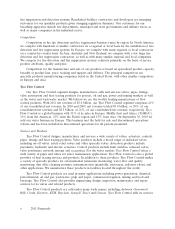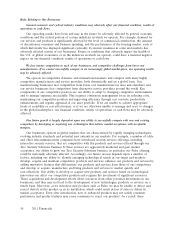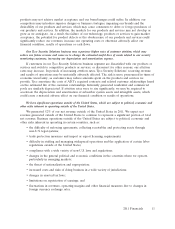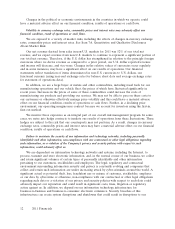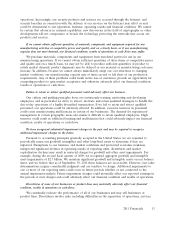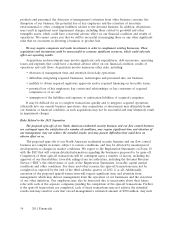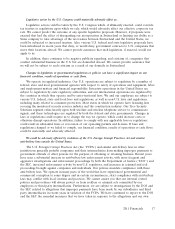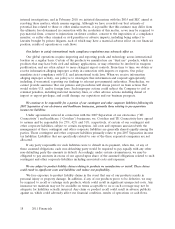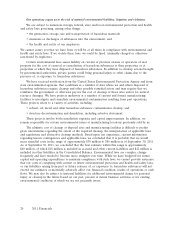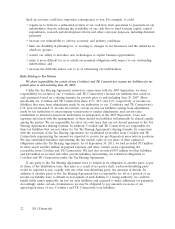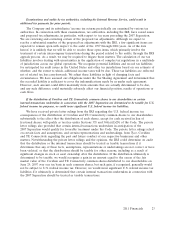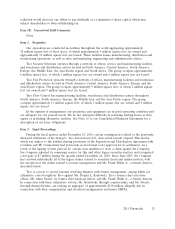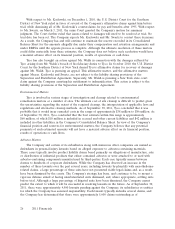ADT 2011 Annual Report Download - page 119
Download and view the complete annual report
Please find page 119 of the 2011 ADT annual report below. You can navigate through the pages in the report by either clicking on the pages listed below, or by using the keyword search tool below to find specific information within the annual report.proposed spin-offs, we intend to obtain tax rulings from the Swiss Federal Tax Administration
confirming that the distributions will not be subject to Swiss federal withholding tax. These rulings will
rely on certain facts and assumptions, and certain representations and undertakings, from Tyco
regarding the past conduct of its businesses and other matters. Notwithstanding the tax rulings, the
Swiss Federal Tax Administration could determine that the Distribution should be treated as a taxable
transaction for withholding tax purposes if it determines that any of these facts, assumptions,
representations or undertakings is not correct or has been violated. If the Distribution ultimately is
determined to be taxable for withholding tax purposes, we and Tyco could incur material Swiss
withholding tax liabilities that could significantly detract from, or eliminate, the benefits of the spin-off.
If the 2012 Separation is completed, our operational and financial profile will change and we will be a
smaller, less diversified company.
If completed, the 2012 Separation will result in Tyco being a smaller, less diversified company
focused on our commercial fire and security businesses, which represents a narrower business focus
than we currently have. We will have a more limited business with greater concentration in the
commercial market and may be more vulnerable to changing market conditions, which could materially
and adversely affect our business, financial condition and results of operations. In addition, the
diversification of revenues, costs, and cash flows will diminish. As a result, it is possible that our results
of operations, cash flows, working capital and financing requirements may be subject to increased
volatility and it may be difficult or more expensive for us to obtain financing. Our operations may also
be impacted by a limited ability to attract new employees in a timely manner.
If the 2012 Separation is completed, there may be substantial changes in our stockholder base, which
may cause the price of our common stock to fluctuate following the proposed spin-offs.
Investors holding our common stock may hold our common stock because of a decision to invest
in a company that is large and operates in multiple markets with a diversified product and services
portfolio. If the proposed spin-off transactions are completed, shares of our common stock will
represent an investment in a smaller company with its business concentrated in the commercial fire and
security industry. These changes may not match some holders’ investment strategies or meet minimum
criteria for inclusion in stock market indices or portfolios, which could cause investors to sell their
shares of our common stock. Excessive selling pressure could cause the market price of our common
stock to decrease following the completion of the proposed spinoff.
Risks Related to Legal, Regulatory and Compliance Matters
We are subject to a variety of claims and litigation that could cause a material adverse effect on our
financial condition, results of operations or cash flows.
We are subject to a significant number of claims and are named as a defendant in numerous
lawsuits, including claims for damages arising out of the use or installation of our products or services,
litigation alleging the infringement of intellectual property rights, litigation alleging anti-competitive
behavior, litigation related to environmental matters, product liability litigation (including asbestos-
related claims), and litigation related to employee matters and commercial disputes. In certain
circumstances, patent infringement and anti-trust laws permit successful plaintiffs to recover treble
damages. The defense of these lawsuits may divert our management’s attention, and we may incur
significant expenses in defending these lawsuits. In addition, we may be required to pay damage awards
or settlements, or become subject to injunctions or other equitable remedies, that could have a material
adverse effect on our financial condition, results of operations or cash flows. Moreover, any insurance
or indemnification rights that we have may be insufficient or unavailable to protect us against potential
loss exposures.
16 2011 Financials


